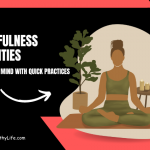
Yoga Teacher Training in the magical destinations of the globe uncovers the soul of meditation– A yogic technique of calming the fluctuations of the mind and awakening the consciousness, which is the heart of yoga.
Meditation is not a religion nor an activity of dreaming, it is the science of fathoming all levels of ourselves, of intensely becoming aware of the present moment, and finally experiencing the heightened peacefulness and responsiveness within. This represents the true essence of meditation.
The practice of meditation undeservedly suffers from a myriad of false connotations and gets praise from only religious practitioners. But, the art of meditation is a complete healing practice to get the lost soul onto the path of inner peace, to calm the mind, to route the journey within, and to live in relaxation– the prerequisite of every modern living entity.
We all encounter episodes of anxiety. We all go through inner chaos and perennial sadness, and we all yearn for peace and contentment. In a stress-bound busy life, Meditation is what everyone needs to know and practice.
The five meditation practices for adoring tranquility and solace that seem to be lost in the glitz and glamor of the fast-paced lifestyle:
1. Yoga Nidra
Yoga Nidra or Yogic Sleep is the stilling of the mind waves through a conscious entry into the sleeping state. How? Yoga Nidra is the practice of becoming aware of different body sensations and focusing on the breath to trigger a relaxation response.
The practice balances the autonomic nervous system, connects the right and left brain hemispheres, and transports the practitioner into a relaxed state: the alpha state of the brain.
Yoga Nidra is the practice for everyone to savor incredible calmness, self-awareness, mental stillness, and quietness.
The 10 steps of Yoga Nidra:
- Become aware of your heartfelt desire: Lie in Savasana, close your eyes, breathe deeply, and connect to your heartfelt desire.
- Set Intention: Reflect on your intention of practicing the yoga nidra. Is it to relax or release the stored emotions? Welcome the intention with your entire body and mind.
- Explore the Inner Resource: Find your inner resource and connect with it. The place where you experience feelings of calmness and well-being.
- Scan the Body: Slowly become aware of each organ of the body. Sense the eyes jaw, thighs, arms, etc. Relax each nerve of the organs.
- Focus on Breath: Become aware of the breath. Feel each pattern and flow of the breath throughout the body.
- Embrace the feelings: Welcome each sensation as it passes the body. Notice the feelings and opposites within the body.
- Welcome the Thoughts: Without judging, witness each passing thought through the mind. Notice the experience without an attempt to change it.
- Experience Joy: Bring a smile to your face and mentally repeat positive things to yourself. Experience moments of joy and bliss spreading within.
- Observe the Self: Observe your personality, anger, frustration, etc. Dissolve into awareness and conscious self.
- Repeat and Reflect on the Practice: At the end of the practice, reflect on the journey you have taken. Feel pure feelings and try to integrate them into your daily life.
200-hour yoga teacher training in Rishikesh can help you dive deep into the understanding and practice of Yoga Nidra.
2. Mantra Meditation
“Om Shanti, Shanti, Shanti” is the sound of the universe and the vibration of calmness. Mantra meditation is a practice of quieting the mind and relaxing the body through the chants of sacred syllables– the Mantra.
Mantra Meditation is an essential practice to deepen self-awareness, create a positive mental pattern, engender compassion, and bring down high blood pressure.
The steps of doing mantra meditation:
- Sit in a comfortable place with an erect body, especially the back, and keep the head in a neutral position and the legs in a crossed position.
- Close the eyes. Either fold the hands in prayer mudra in front of the chest or rest it over the thighs, palms down.
- Chant the mantra slowly. At the end of the practice, rub the hands together and touch the face and body with it.
3. Mindfulness Meditation
Mindfulness represents the ability of human beings to be fully present in the current moment. An effective meditation technique inspired by Buddhist teachings– Mindfulness meditation is avowed to reduce stress, develop concentration, and help you live in the present moment. Plan for a Mindfulness Yoga Retreat in Rishikesh to experience absolute bliss.
Mindfulness meditation tips:
- Be present at the moment while meditating.
- Concentrate on the inhales and exhales.
- Observe the inner thoughts, and external sensations without trying to alter them.
- Become comfortable with the experiences.
- Stay there and gradually release happily.
4. Transcendental Meditation
A form of silent mantra meditation introduced by Maharishi Mahesh Yogi for cultivating internal peace and an overall sense of well-being. Scientific researches on Transcendental Meditation reveal its power to lower stress, cholesterol levels, depression, and heart failure, and to promote longevity.
5. Vipassana Meditation
A traditional Buddhist meditation practice focusing on the breath and body helping the practitioners see things in their true light. Learn the art of focusing on the breath and becoming aware of one’s thoughts and experiences through Vipassana Meditation.
Meditation is the journey of relaxed, calm, and a mind focused inward. With these five meditation practices, explore and become your best ‘self’.
About The Author:
Manmohan Singh is a passionate Yogi, Yoga Teacher, and Traveler in India. He is currently working with rishikulyogshsla.org. The Yoga Alliance-affiliated school organizes several Yoga events such as Yoga teacher training in India, Yoga workshops, Retreats, Pranayama training, etc.




